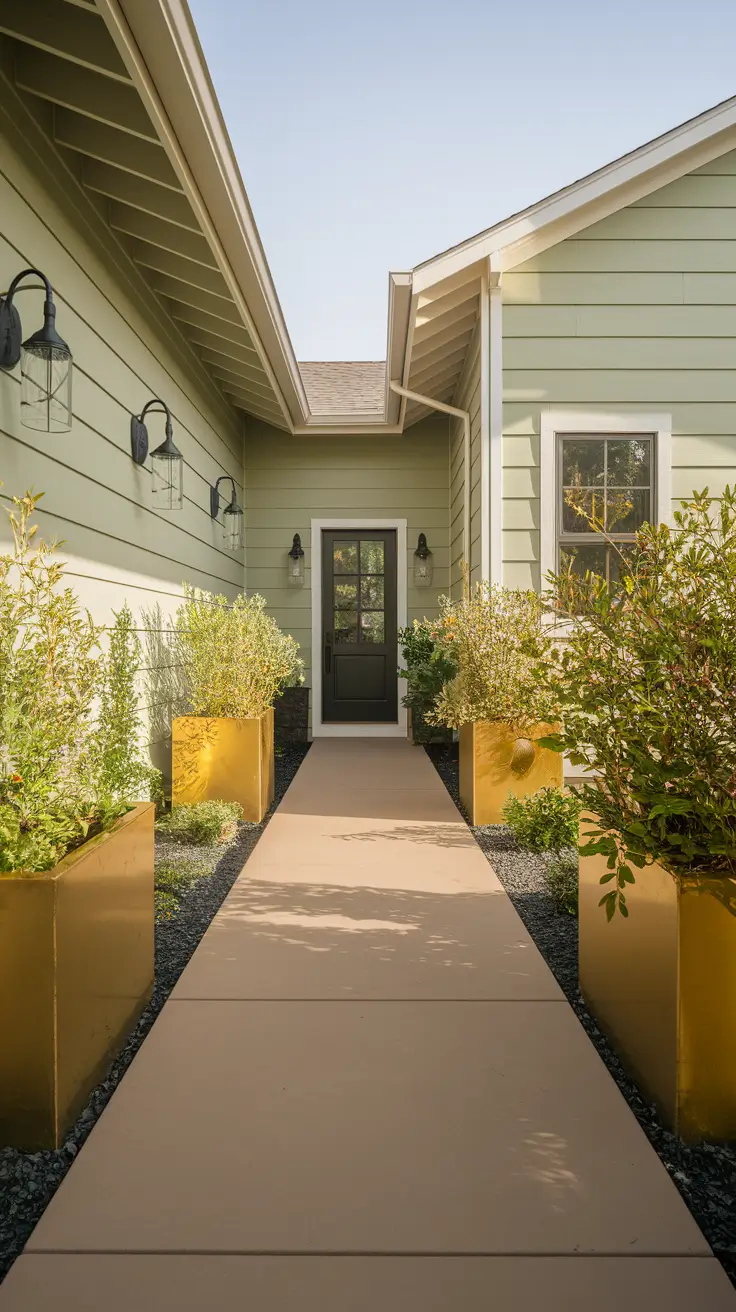21 Best Green House Exterior Ideas for a Fresh and Elegant Look

Looking to refresh your home’s curb appeal? Want to learn how a green house exterior can make your home more attractive, stylish and environmentally friendly? I’ll show you green house exterior ideas that are both beautiful and useful in this article. From pairing hues with white trim to enhancing facades with natural plants, we’ll cover innovative paint choices, trim details, and architectural influences. If you’re planning a big change for your home’s design, these ideas will inspire you and still keep things functional.
Charming Green House Exterior Ideas to Inspire Your Next Makeover
One of the most effective ways to rejuvenate a home’s appearance is with a green house exterior. Whatever your color preference, sage, forest or mint, it helps your home fit in with the outdoors and still be noticed. I believe that green looks great with any type of architecture, giving homeowners a lot of flexibility in how their home looks. Choosing the right shade and trim helps maximize your home’s visual impact.
I suggest using green siding with neutral siding colors and adding a roof that matches with taupe or charcoal shingles or metal. Putting gold or off-white planters by the front door gives the space a touch of elegance. Matte black sconces add a touch of elegance to the facade, but without taking away from the main colors used.

Green exteriors seem to work well no matter what time of year it is. In the spring and summer, they match the greenery, but in the fall and winter, they add warmth. Better Homes & Gardens reports that green is one of the friendliest colors for home exteriors this year.
I think adding dark trim or light accents to your home can make this look stand out even more. This balance ensures the home doesn’t appear flat or overly bold.
Timeless Appeal: Green House Exterior With White Trim
The combination of a green house exterior white trim is timeless, evoking classic charm with a crisp, clean finish. I’ve always noticed how white trim helps the windows and doorways stand out, making the green stand out without seeming too loud. This combination looks great on craftsman and colonial houses, giving them both strong contrast and a bright front.
I often choose pure or warm white for trim and this looks great with hunter or emerald green. If you paint the architectural moldings white, vinyl or fiber cement siding in sage or pine green will look great. Put white and blush flower boxes under each window to maintain the overall look of the house.
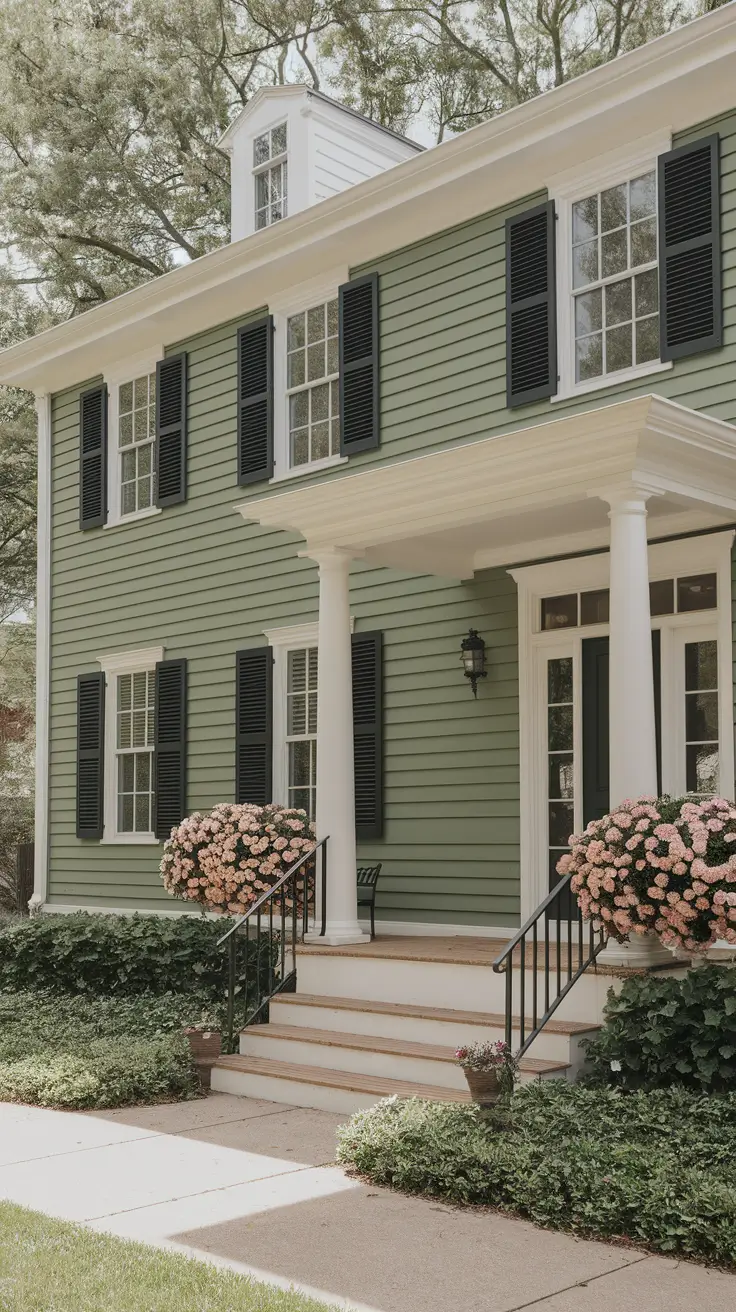
I think white trim black shutters really make this style stand out. This trio—green, white, and black—adds elegance that doesn’t date. According to Southern Living, the reason this pairing is so popular with homeowners is its simple elegance.
I also think that white trim porch columns or railing would help unite the different design parts of the house.
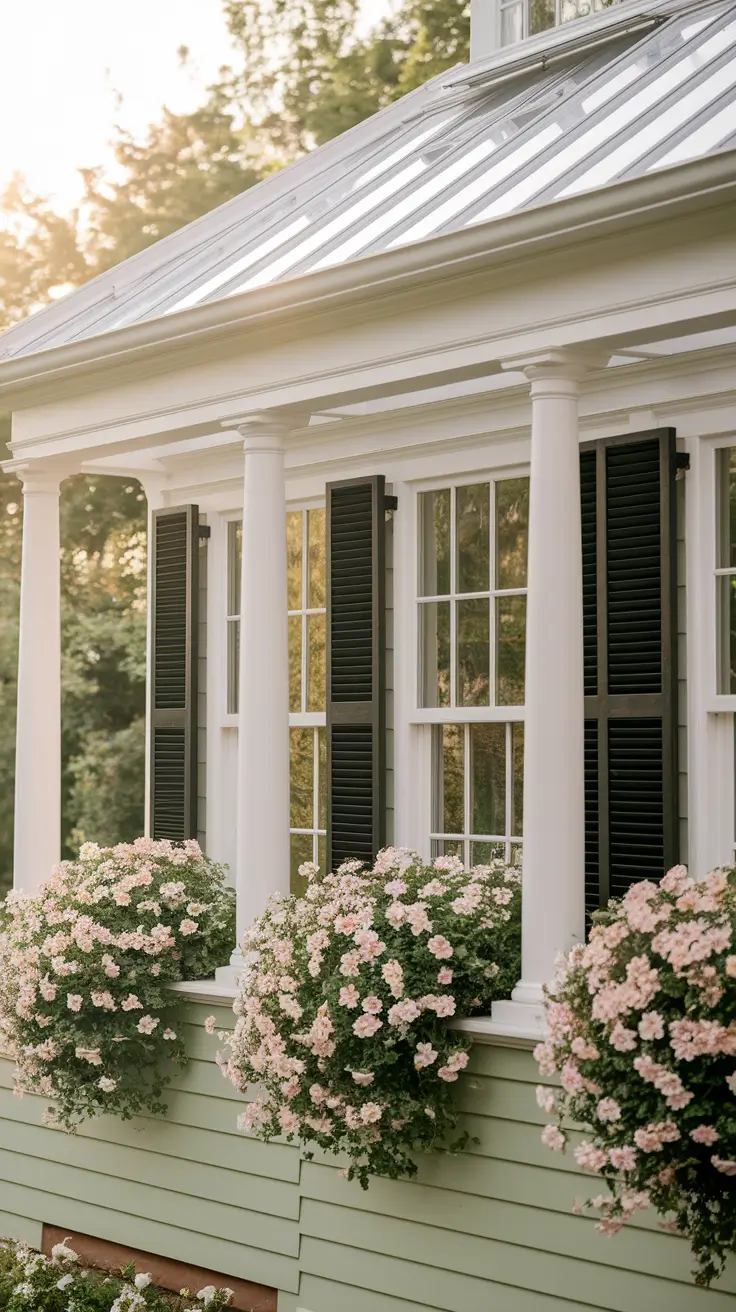
Lush and Natural: Embracing Plants in Your Green House Exterior
Incorporating green house exterior plants into your home design offers a seamless blend of natural beauty and intentional landscaping. I think that vertical gardens, built-in planters and climbing vines add rich texture and greenery to green siding. If you are an eco-conscious homeowner, this idea can help you add interest to your home’s exterior without harming the environment.
I’d go with natural stone or wood planter beds placed close to the porch or entryway when it comes to design. Plant evergreen shrubs for stability, seasonal perennials for color and ornamental grasses for movement in your garden. Planting ivy or jasmine on the front of a house creates height and matches well with green exterior paint.
I think this approach helps the home feel connected to its surroundings. HGTV recommends planting in groups or repeating the pattern to get a professional look in your yard.
For an even better idea, install irrigation systems or raised herb gardens by the entrance to improve both use and sustainability.
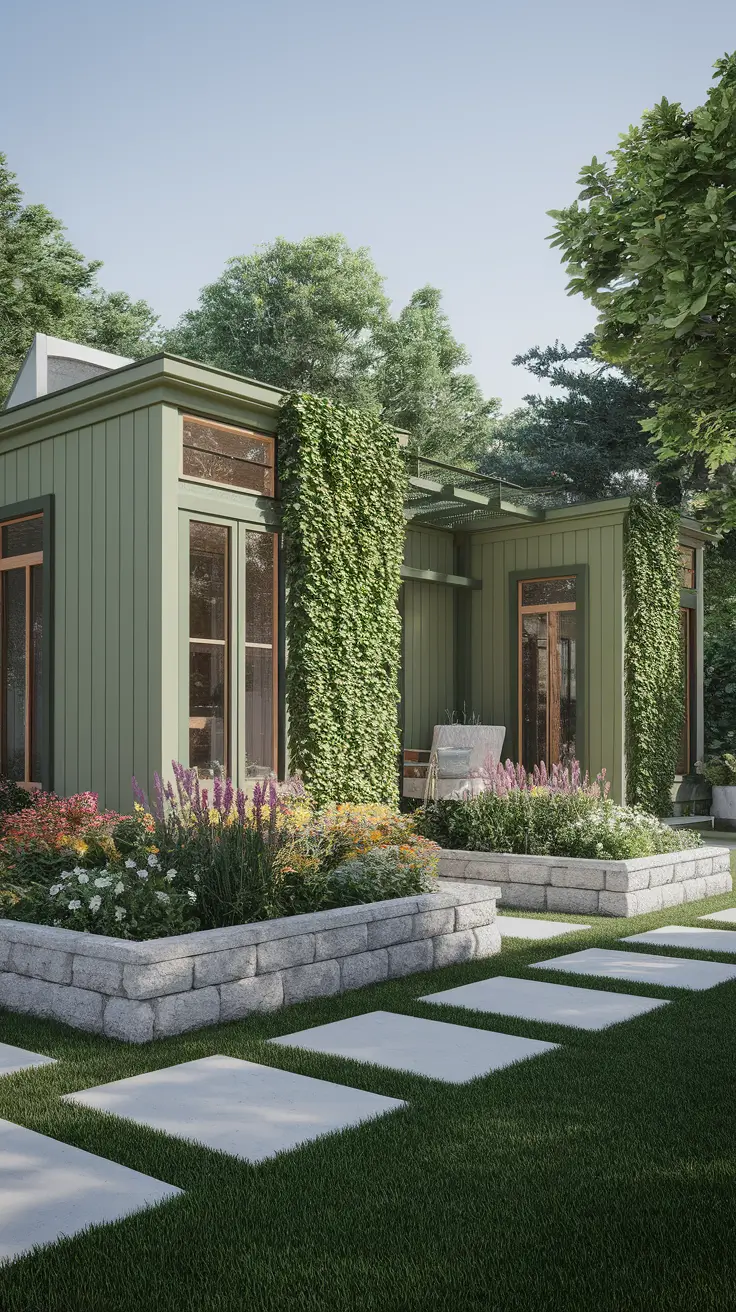
Bold Contrast: Green House Exterior With Black Trim
A green house exterior black trim creates a striking contrast that modernizes even the most traditional structures. I like to use this combination with deep green tones and it can match farmhouse, mid-century and Victorian homes. The black background holds the green colors together in a clean way.
I usually go for matte or satin black on my trim, shutters and front doors. These elements provide visual weight without overwhelming the facade. The black lighting fixtures, mailbox and house numbers are all part of the same design. If you can see the rafters or fascia boards in your home, painting them black makes the design more striking.
For all of my design projects, this color scheme has always given the property a striking and elegant look from the street. According to Architectural Digest, black contrast trims are becoming popular because they give a room a sleek, modern look.
If you want a more dramatic effect, I’d suggest black-framed pergolas or railings that follow the trim design and bring together various parts of the yard.

Sleek and Stylish: Green House Exterior With Black Windows
Combining a green house exterior black windows layout delivers both luxury and edge. A modern look is created on the outside, mainly when the siding is sage, olive or eucalyptus green. What I like about this setup is that it highlights the windows, giving the space depth and a modern look without altering the building.
If your windows have black aluminum or composite frames, they will look great with lighter green paint. Choose window designs that have simple, clean lines without a grid. You might also try using exterior lights in warm brass or matte bronze to bring some warmth to black. Neutral-toned planters and subtle landscaping help balance the look.
I think that black windows can improve the look of almost any modern or transitional home. Forbes Home believes black-framed windows are a top choice for exterior design this year thanks to their striking look.
To complete the space, you can put on black roof trim or rain gutters that go well with the window design for a better-looking front.
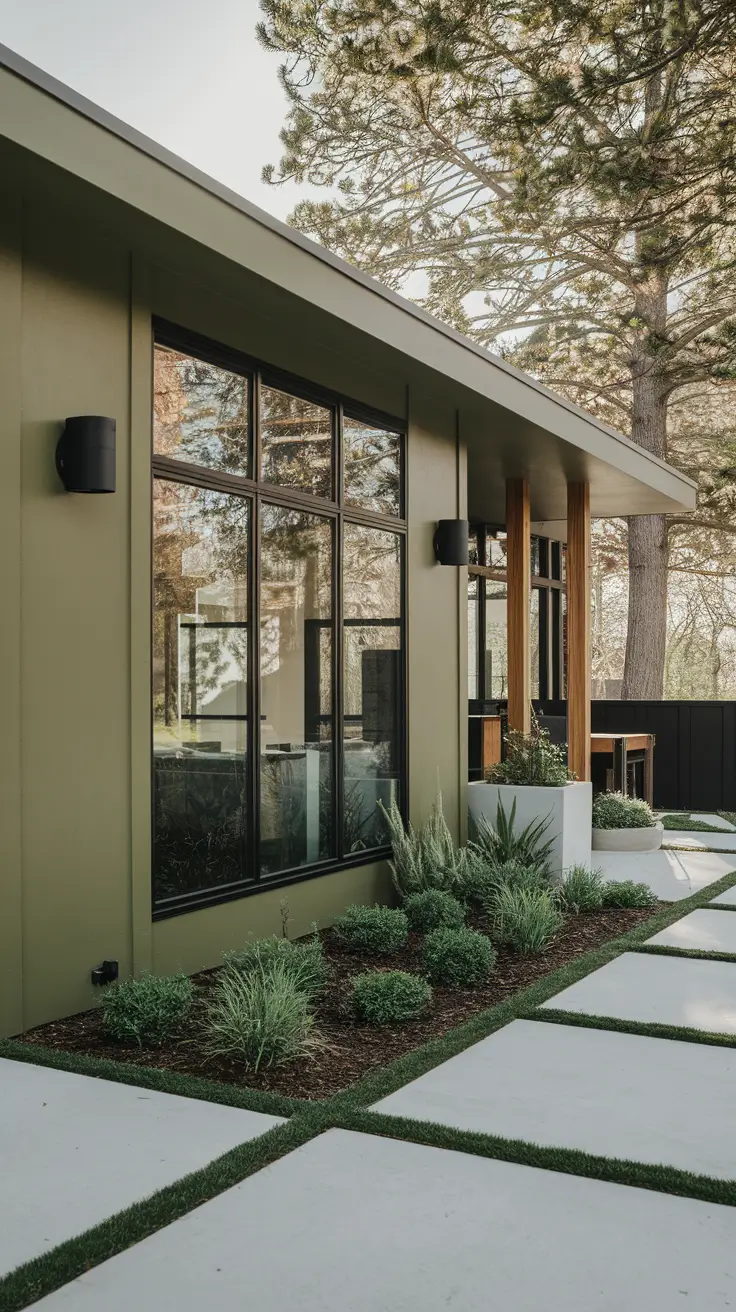
Choosing the Right Paint for a Green House Exterior
Selecting the ideal green house exterior paint is foundational for achieving the desired mood and harmony in a home’s design. You should start by looking at your neighborhood—would you prefer your home to match the area or to be different? Consider the trees around your home, the type of light you get from the sun and the local weather.
If you want a base, muted greens like moss, eucalyptus or pistachio will always look elegant. I usually use paints from Sherwin Williams such as “Basil” and “Sage Light,” because they are high quality and have a lot of color. Pick paint colors that have undertones that match your home’s siding, trim and roof.

I have found that the paint finish is just as important as the color. If you want a finish that lasts well outside, choose satin or matte. The team at House Beautiful emphasizes that undertones (blue, gray, yellow) in green paint significantly affect its appearance throughout the day.
It’s also a good idea to try out your green color in several spots on the outside before making a final choice. Lighting can change the look of the color in various materials and at different times.
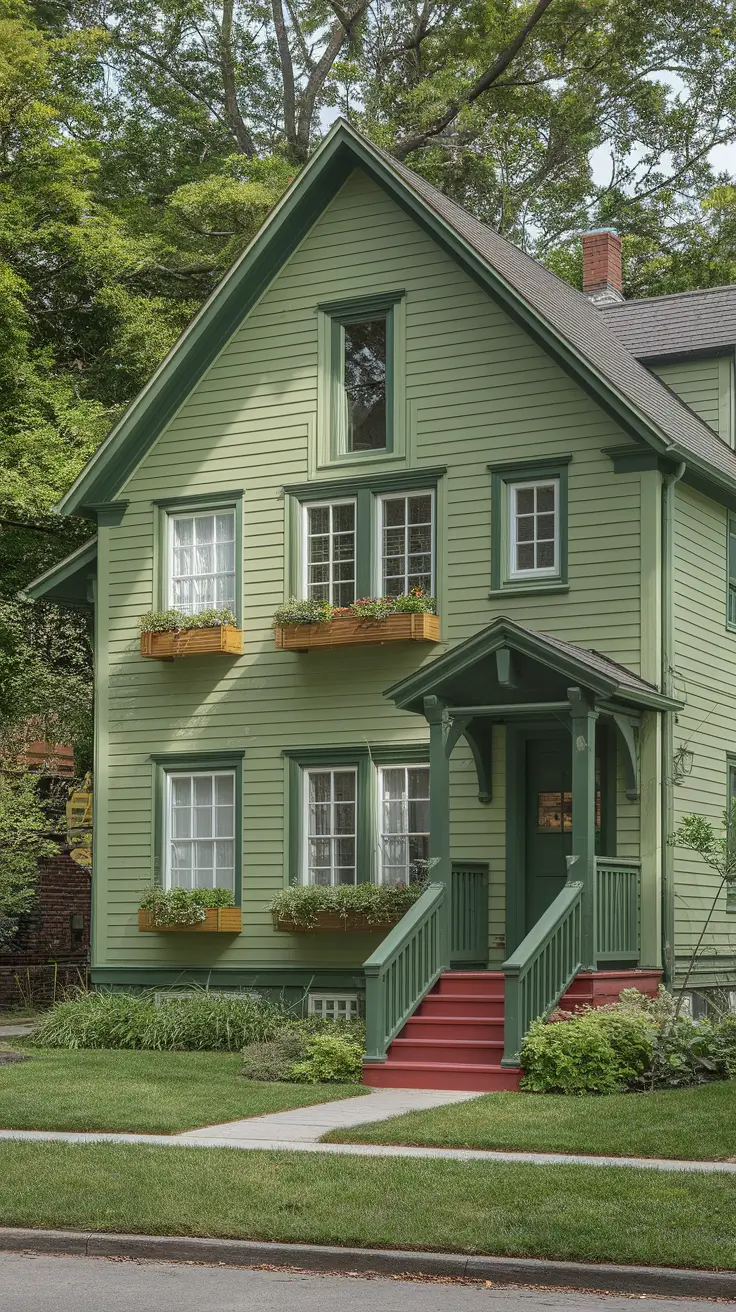
Rustic Warmth: Green House Exterior With Brown Trim
Pairing a green house exterior brown trim creates a grounded, earthy feel ideal for cabins, cottages, and rustic-style homes. I find that brown elements, mostly in wood, give green exteriors a cozy and interesting look. This method seems especially suited to environments that are forested or rural.
I choose walnut or chestnut for the trim and I stain it if the material is wood or paint it if it’s a different type. Choose siding in olive or sage green and then use natural materials such as stone or brick. Wood-framed doors and exposed beams complete the rustic look. All of my outdoor spaces are finished with bronze or copper lighting and hardware.
The combination brings to mind Adirondack homes which depend on natural materials for their lasting durability. Country Living points out that using green and brown in your home can help you feel more connected to nature and safe.
For an even better result, I’d recommend adding terracotta planters, a wooden deck or gravel paths to ease the change from the house to the garden.
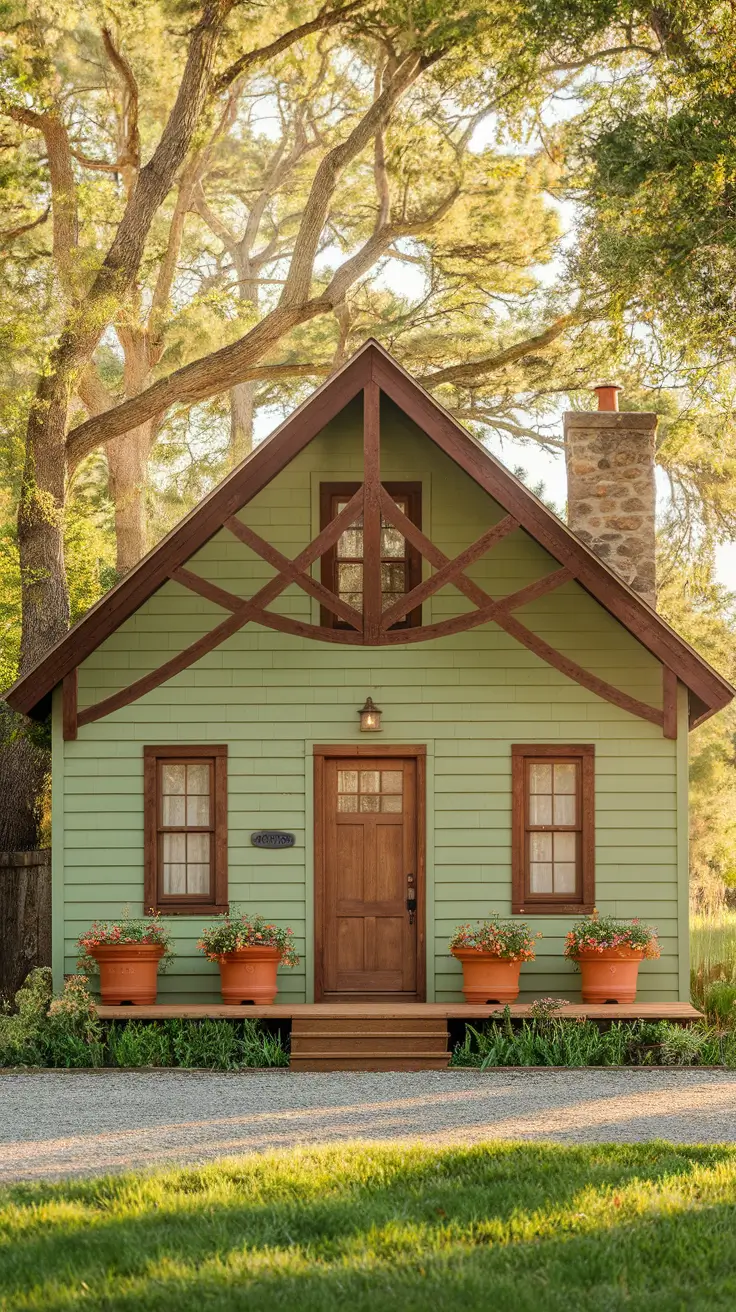
Timeless Texture: Green House Exterior With Brick Accents
Adding green house exterior with brick elements introduces texture, durability, and architectural character to any home facade. I notice that brick is a great way to break up big areas, especially if you use it with green siding. It also draws attention to important architectural parts such as foundations, chimneys and the entrance.
Most of the time, I use either red or earth-colored brick as a base or accent around the porch and the lower part of the house. It looks great paired with either dark or light green. Adding brick column bases or steps gives your space a cozy feel and makes it more interesting. Put metal planters and aged wood furniture in your space to create balance between rustic and modern styles.
I think it’s great how brick and green exteriors match in older neighborhoods, giving the area a unified yet modern appearance. HGTV points out that painting brick with colors that match well adds both depth and beauty to the front of your home.
Another way to make this design better is to play with the mortar colors—gray or buff mortar can really change the appearance of the wall. Adding a white or taupe border can unite all the colors in the room.
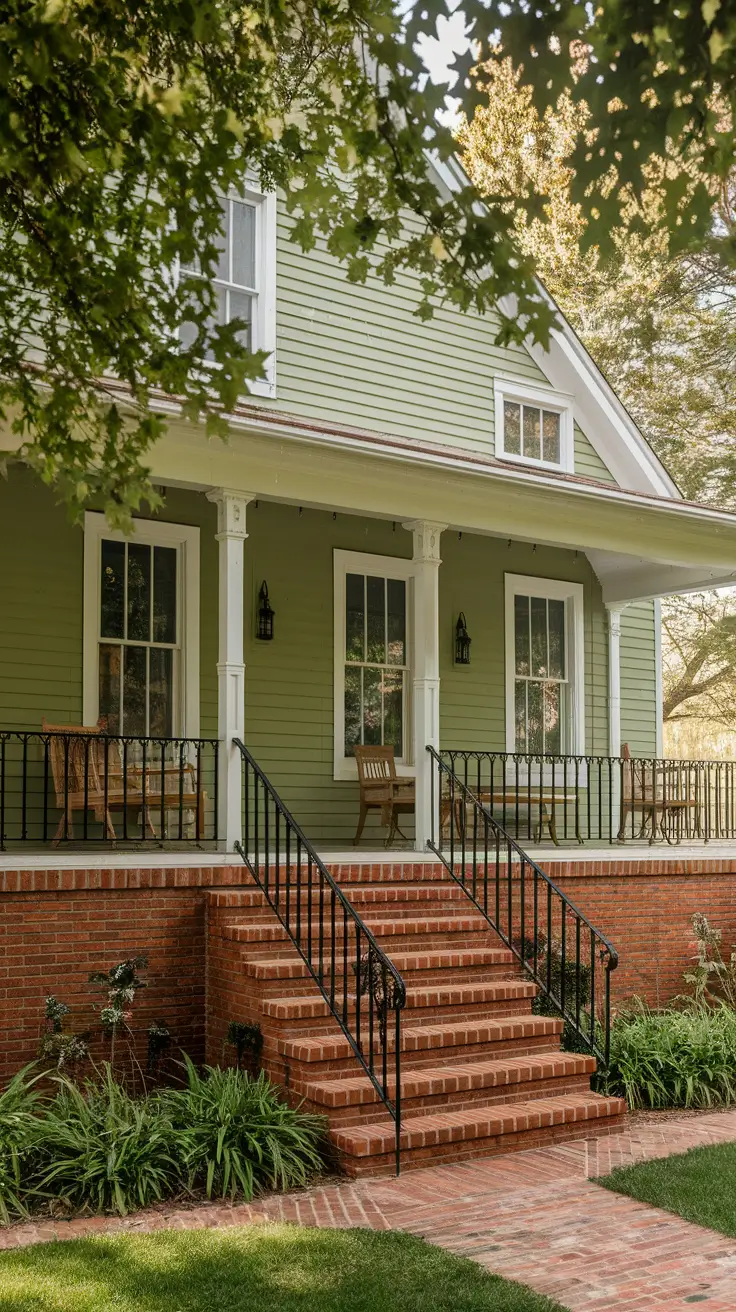
Fresh Combinations: Popular Green House Exterior Paint Colors
Choosing the perfect green house exterior paint colors requires thoughtful coordination with your roof, landscaping, and neighborhood vibe. I first paint the base of the room green, using olive, sage or forest and then add accent and trim colors on top. This gives homeowners flexibility while maintaining balance.
In my palette planning, I often combine Sherwin Williams greens like “Retreat,” “Evergreen Fog,” and “Privilege Green” with soft neutrals or rich earth tones. The colors suit a range of lighting and look lovely when used with natural siding materials such as wood or fiber cement. Install black light fixtures and use natural stone to finish the outdoor area.
I have found that homeowners should choose colors that express who they are, but also fit in with the local building style. Southern Living suggests that you test paint samples in your home and check them at different times of day before you buy.
I think it’s important for homeowners to remember that seasonal landscaping can change the way paint appears. The presence of trees, flowers or snow can add a touch of color to or take away from, the green in a landscape all year.
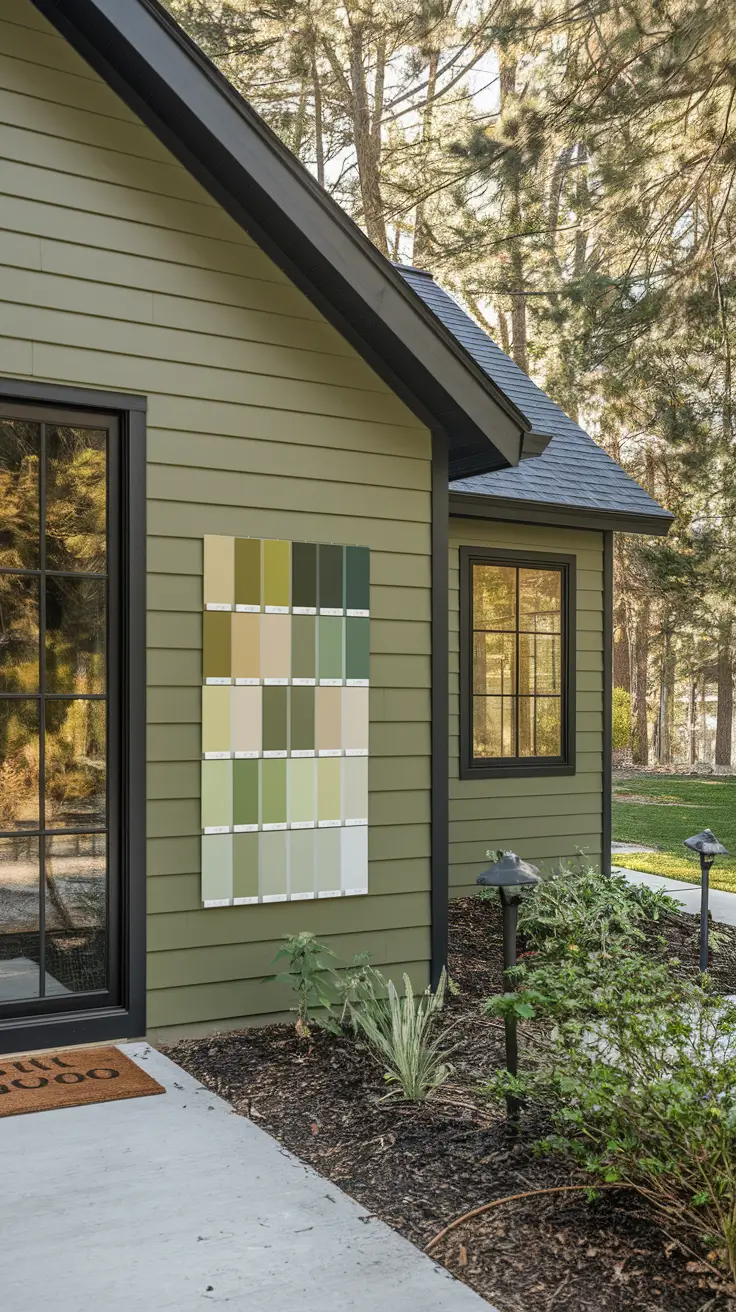
Curated Color Palettes for a Beautiful Green House Exterior
Developing green house exterior color palettes is a design process that brings harmony, contrast, and personality to a home’s facade. I advise clients to consider the whole exterior as a collection of parts, instead of selecting paint colors on their own. The key is creating balance between boldness and subtlety.
I like using olive green with creamy white and warm wood and sage green with pewter and brushed nickel. Using emerald green with black or dark charcoal makes a room look stylish and modern. The way the palette is seen depends greatly on the roof color, trim style and hardscaping.
I frequently find ideas in nature such as moss on rocks, pine trees against the sky or herbs in a clay pot. Better Homes & Gardens experts say that using colors inspired by nature helps a home blend better with its environment.
In addition, homeowners can find software or apps that allow them to see how different colors will look on their house before they buy. It helps bring confidence before purchasing gallons of paint.
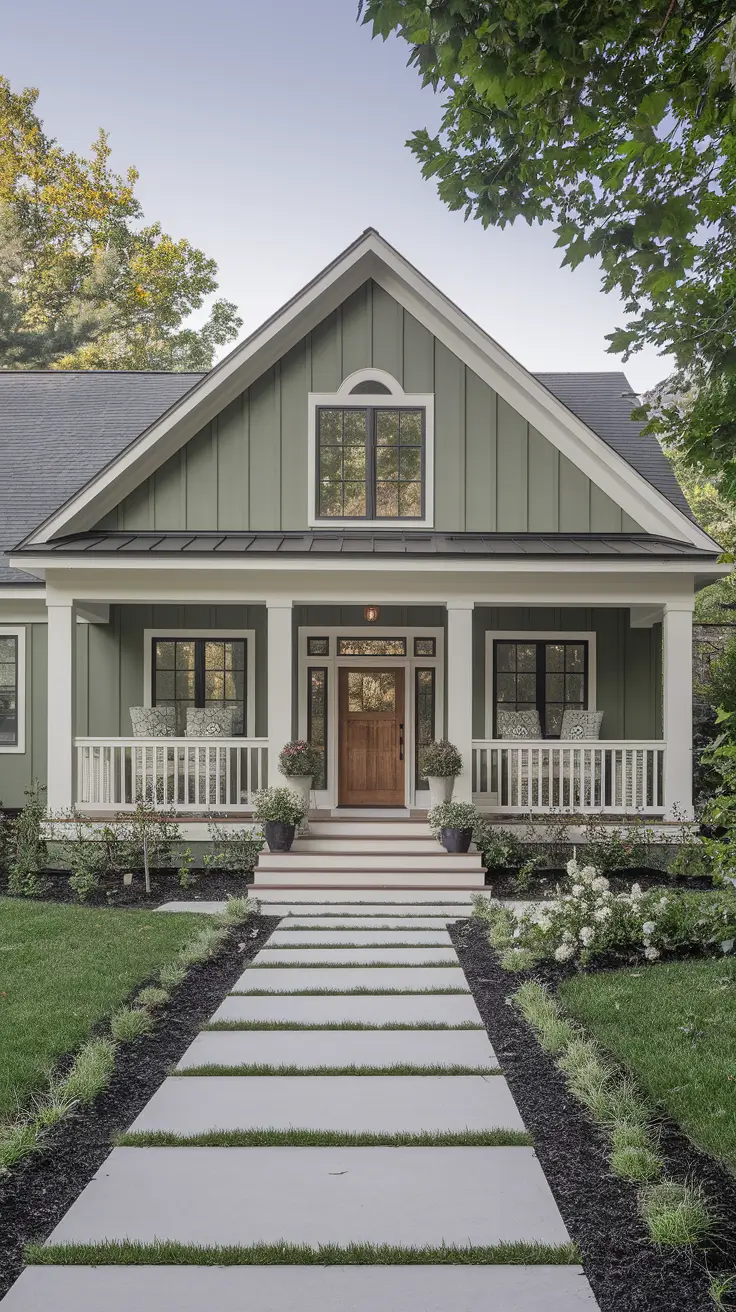
Elegant Stone Details for Green House Exteriors
Incorporating green house exterior with stone design features adds rich texture, natural beauty, and a sense of permanence. I find that stone works well as a base—in the walls, chimney or columns of a building. It matches green surroundings with a natural touch and makes the home look even better.
It’s best to use natural gray or beige-colored stones like limestone or slate. These pair effortlessly with light and olive green paints. Stone veneer panels work for more budget-conscious projects. Stone paths or stairways help make the home’s design match its surrounding landscape. Iron benches and wooden rocking chairs seem to fit in perfectly at this place.
I believe that stone gives a green home exterior a sense of permanence and elegance. Architectural Digest has pointed out that using a mix of materials such as natural stone and light green, is becoming popular again.
You can make this idea even better by illuminating the stone sections at night with warm LED lights from below.

Soft and Earthy: Olive Green House Exterior Styles
One of my go-to tones for a subtle, natural look is an olive green house exterior. Olive is very adaptable—it’s soft and sturdy at the same time without being too quiet. Olive gives any home, whether in the suburbs or surrounded by trees, a friendly and comfortable feel.
I usually put olive siding with light tan or taupe trim and black hardware. A front door looks great when painted dark green or burnt orange. Adding natural wood and terracotta pots to your decor helps the olive paint look more inviting. Plant some trailing or vertical plants near the edge to make it softer.

For me, olive is a color that doesn’t get used enough on the outside of homes. Olive green is becoming more popular both inside and outside homes, says Veranda, thanks to its natural beauty and soothing effect.
To make this concept stand out, paint the body of your home dark olive and the dormers or gables a lighter olive. It adds subtle depth and visual variety.
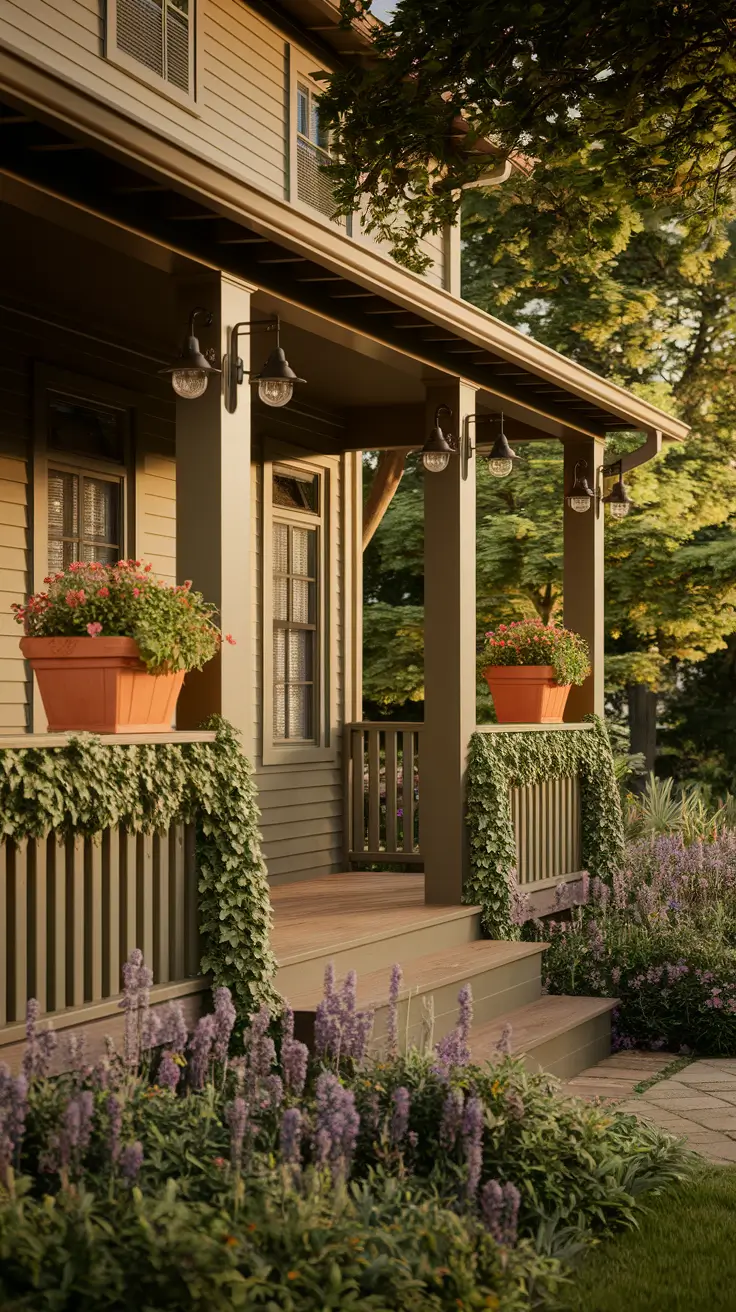
Harmonious Color Schemes for Green House Designs
Coordinating the right color schemes for a green house exterior ensures a visually appealing and coherent appearance. I suggest homeowners begin by choosing the main green color and then pick a couple of colors for the trim, doors or railings. This triadic approach keeps the design intentional and refined.
A favorite look of mine is sage green as the main color, creamy white for the trim and dark bronze on the front door. Another beautiful combination is to use light eucalyptus green, charcoal shutters and a natural wood front entry. A roof in slate gray or bark brown will help unify the colors in your home. Remember to include landscaping in your design; matching the color of mulch or gravel can make everything look better.
In my opinion, choosing a pleasant color scheme makes the home appear better organized and professionally designed. Real Simple points out that keeping colors simple and matching them often works better than trying bold designs on your home’s exterior.
To finish the theme, you could use striped cushions for your porch or place entry rugs in matching colors. It adds polish and consistency.
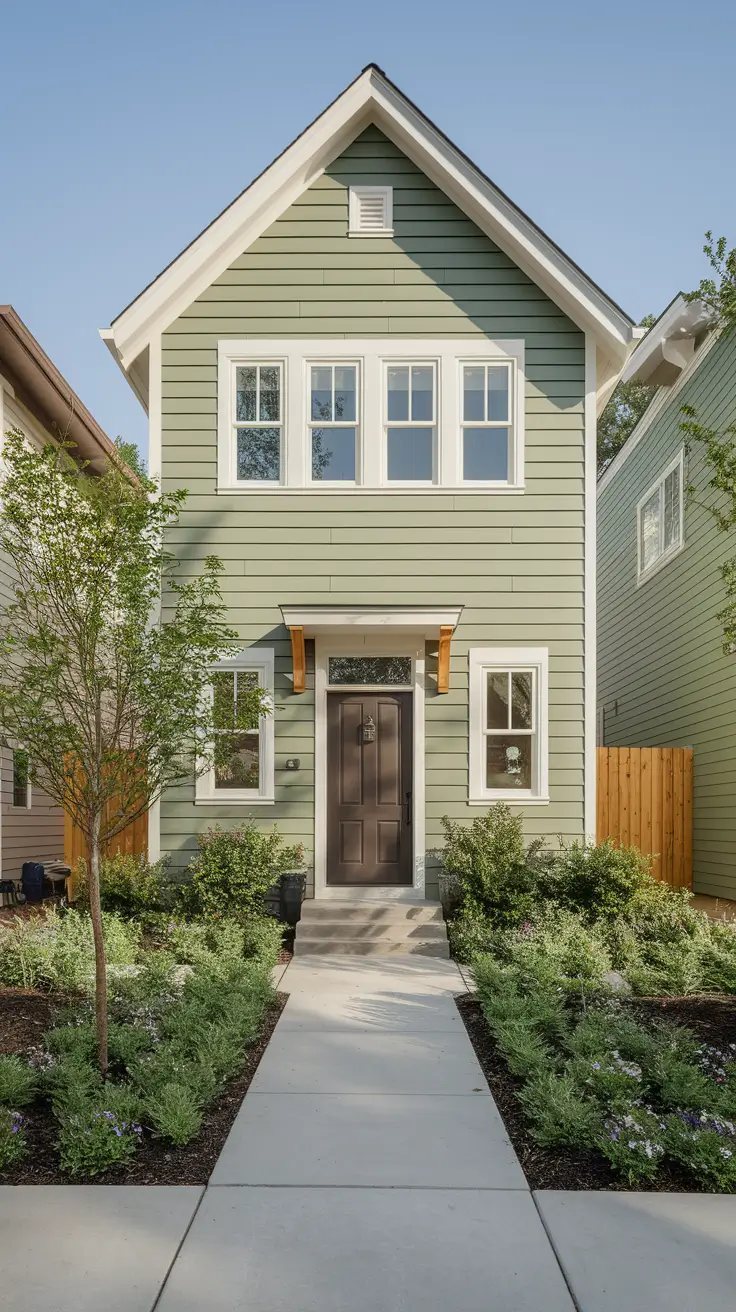
Bright and Airy: Light Green House Exterior Ideas
Opting for a light green house exterior opens up the design to feel fresh, inviting, and perfect for coastal, cottage, or minimalist homes. I like that light green looks good next to nature and reminds us of the openness and peace that come from the sky or plants.
My favorite look in this setting is to use light mint or pistachio on the sides, white trim, black shutters and brushed nickel fixtures. The use of white wooden railings and neutral pavers will help soften the area. Adding lavender or white flowers at the front of your house makes the space feel even more cheerful. A hanging swing or rocking chair will give your room a cozy and used feel.
I love using this style in homes that are not too big or too small. Country Living reports that light green on the outside of a house can make it seem bigger and more inviting—especially when lots are close together.
For a better result, you could add glass-paneled front doors or side lights to bring more light inside and keep the room open and bright.
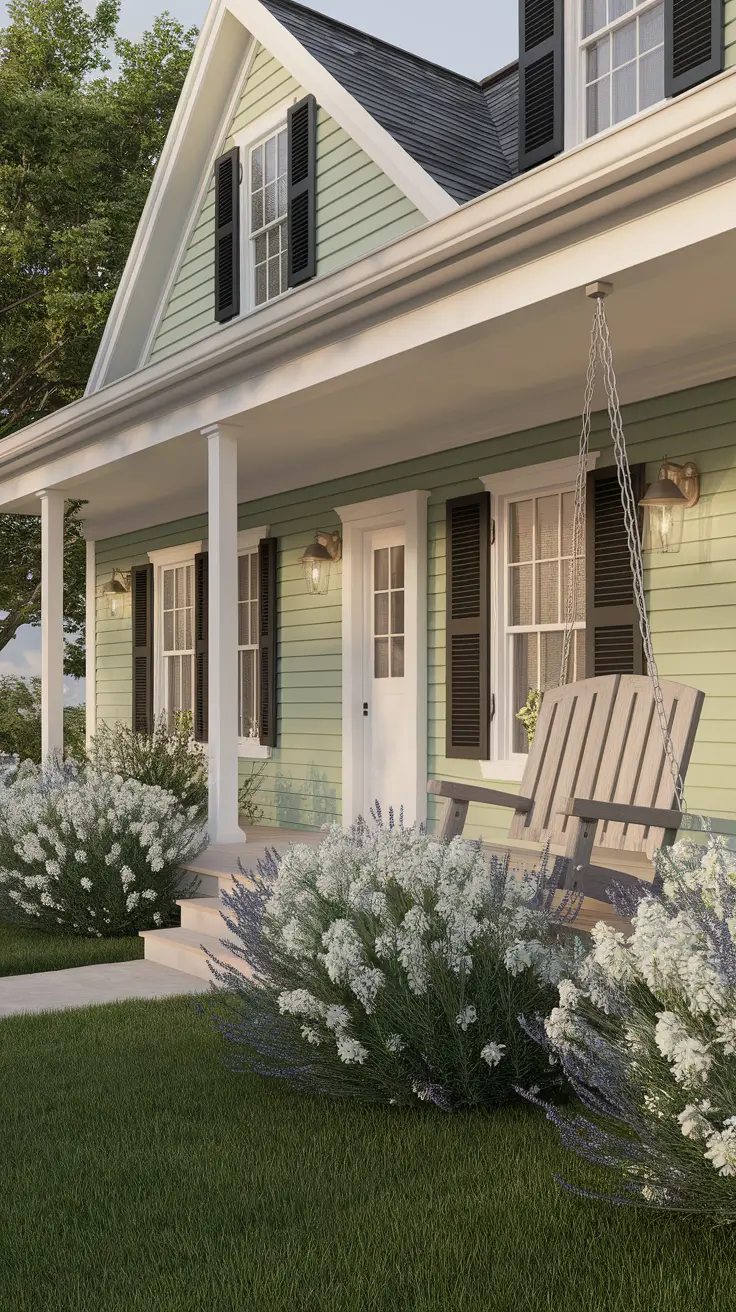
Moody and Sophisticated: Dark Green House Exterior Designs
A dark green house exterior has a way of showing depth, elegance and grounding energy. A number of home projects I’ve done have seen a stately and moody look created by a rich, dark green color on the façade. If you like to make a statement with your home, this style is perfect for you, as it never goes out of style. It also fits well into nature, making the area look peaceful.
When selecting paint for this style, I tend to pick matte or satin green for the outside of the house in deep pine, hunter or spruce colors. Black-trimmed windows and doors improve the appearance and give the house a modern look. Matte brass sconces and dark metal lanterns give a room a simple and refined look. I often suggest using a charcoal roof and adding wood or stone details to balance the look of this exterior.
I believe that a dark green exterior gives you the most freedom to design your landscape. If you want to brighten the look of your greenhouse, try planting pale grasses, lavender or white hydrangeas outside. Homes with a strong contrast in their exterior colors have been found to attract more attention in recent real estate surveys, as Architectural Digest reports.
A lot of the time, I feel that what’s missing is a warm material such as reclaimed wood planters or cedar decking, to contrast with the cool darkness. The result is a space that is both livable and inviting.

Botanical Touch: Enhancing Green House Exteriors With Plants
It’s not a true green house exterior without including plenty of greenery. Since I believe in living with nature, I usually suggest adding green house exterior plants that match the home’s look and design. You can use climbing plants, flowering shrubs and local grasses to make the area between the house and the yard seem more natural.
I make use of different planting methods: tall trellises for ivy and clematis, boxwood or hostas around the foundation and seasonal flowers along the borders. Having window boxes with ferns or herbs gives your home a fuller appearance and cozier feel. The garden is finished with a pair of potted citrus trees and ornamental grasses at the entrance.
I think homes that are built with plants in mind look both cared for and timeless. In fact, Better Homes & Gardens points out that adding just a few plants can make your home seem more attractive and valuable. Going one step further, you can add botanicals to the structure itself such as over arbors or pergolas.
I think including vertical gardens or green wall panels would make this section even better, as they are now popular in eco-friendly homes. They give dimension while saving space.

Classic Charm: Traditional Architecture in Green House Exteriors
Traditional architecture’s classic beauty fits perfectly with ideas for green house exteriors. I’ve completed projects on colonial and craftsman homes where gently colored greens made the gables, dormers and siding stand out. Most of the time, these buildings require a traditional and lasting style for their color and trim that honors their past.
I paint the outside of the house with sage or moss green to get this look. The soft colors blend nicely with white trim, black shutters, many-paned windows and roofs that slope upward. Corbels, traditional lights and evenly arranged plants finish the design. I use painted clapboard, cedar shingles or brick to give the pieces a real texture.
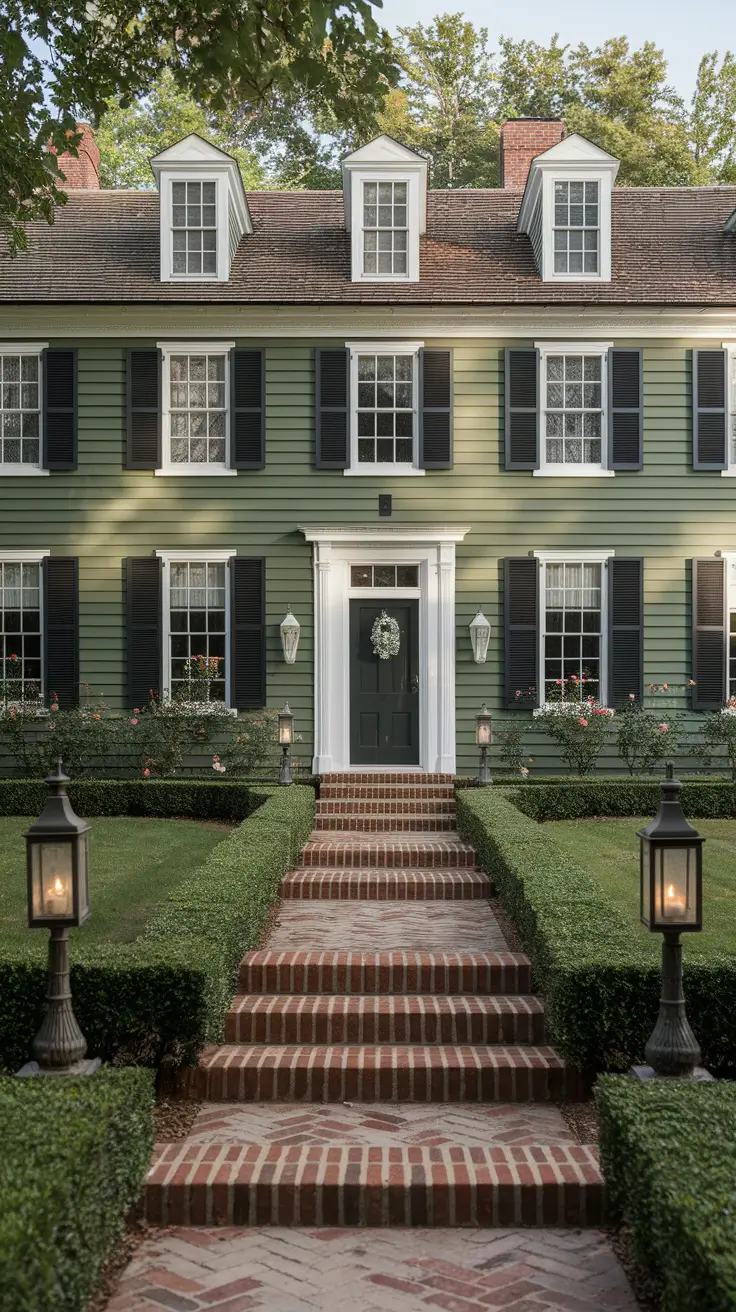
Personally, I feel that these homes represent pride and heritage. This Old House points out that keeping the classic look of a traditional home while upgrading it can give you the highest return when you sell. Many times, I tell my clients to preserve their original doors and millwork and just give them a new look.
Expanding this section, I’d advise including Sherwin Williams historic green colors from their heritage palette which are made for use in older homes.

Clean Lines: Modern Green House Exterior Inspirations
I pay attention to minimalism, geometry and contrasts when designing the exterior of a modern green house. Often, these homes are designed with big windows, flat or gently sloping roofs and a mix of metal, stucco and engineered wood. A home with black windows or black trim and darker green siding looks more elegant.
I enjoy using matte green exterior paint on horizontal siding, large paneled glass and dark slate for the roof. I tend to avoid fancy trim and choose to have gutters hidden by the roofline. I like to use steel planters, linear pavers and sculptural designs for the outside of a house. Lighting is built into the ceiling or walls to keep the area looking simple.
Many clients mention that they feel calm and uplifted because of this type of design. Dwell Magazine often notes that modern exteriors make a home unique in its area and still seem classic. One suggestion I give is to go for high-quality siding that doesn’t need much upkeep to keep your house looking new for a long time.
A great way to improve this block is by installing smart outdoor lighting or solar-powered features.
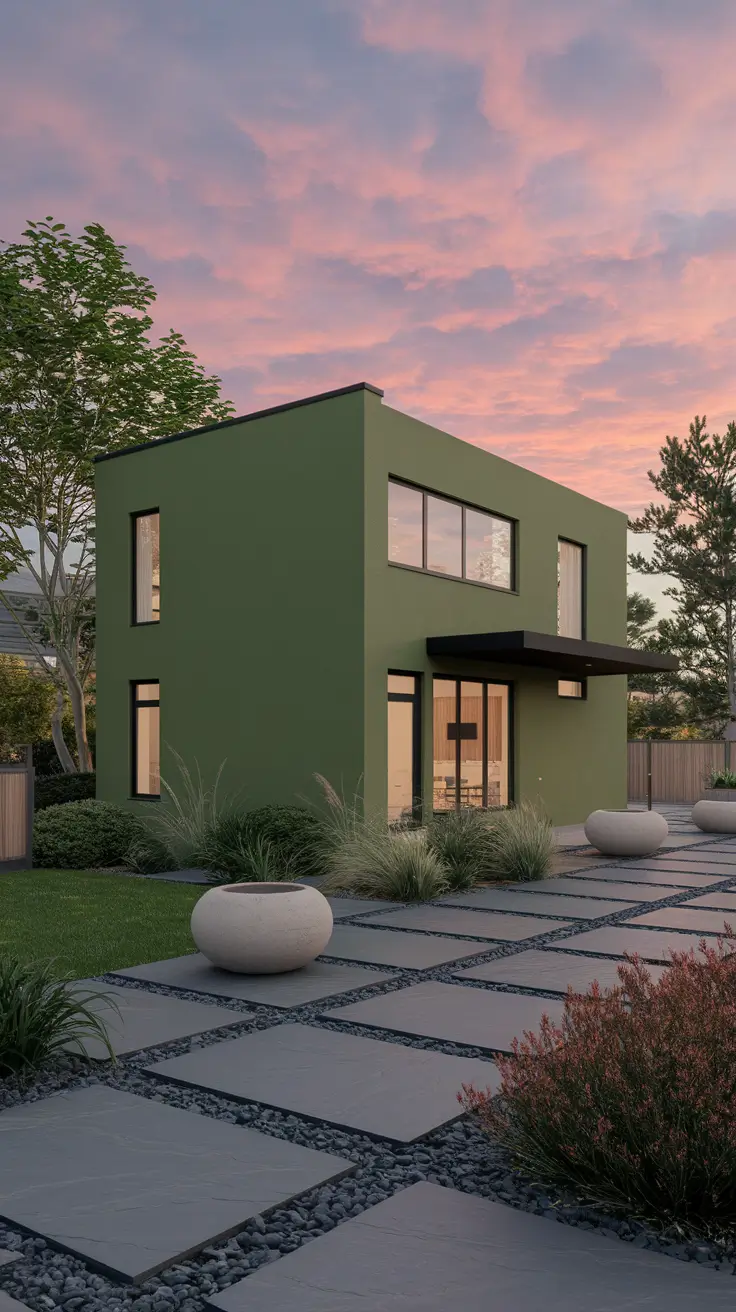
Siding Options That Pair Well With Green House Colors
Choosing the right siding is key to making any green house exterior design work well. I’ve helped a lot of homeowners make this choice, as siding affects both the strength and the look of the house. If you pick contrasting colors, your siding should stand out, while blending ones should match the rest of the house.
I prefer to combine deep green colors with siding in natural wood or slate gray, especially if it’s cedar or fiber-cement. If you want a lighter green, white-washed or taupe board-and-batten is usually my advice. Shiplap and shakes give your home a traditional look, but smooth planks are more suited to modern styles. Matching the house with stone or brick can make the design look better.
I think the success of any exterior starts with the materials used. As emphasized in Houzz’s 2025 Exterior Trends, sustainable siding with earthy tones is highly favored. In places with changing weather, I prefer materials that last, keep the home insulated and are simple to maintain.
I suggest including an analysis of color schemes that use composite siding that copies natural materials yet holds up well over the years.

Finding the Perfect Green House Exterior Paint Shade
Many people begin their search for the best green house exterior paint by considering the undertones, the amount of sunlight it will receive and the style of the neighborhood. I’ve used different paint colors in real environments and my experience shows that picking the right shade is about balancing your preferences with the environment.
When the area gets plenty of sun, I prefer greens with gray undertones such as sage or pewter green. Warm olive or khaki greens are my favorite choice for shady lots. Testing swatches at different times of day is crucial. I find it enjoyable to use three shades of green for the exterior of a house: one for the siding, another for the trim and a third for shutters or railings.
Often, my clients don’t realize how important light is for color. According to Sherwin Williams’ exterior experts, even the same paint can look drastically different under direct sun versus shade. It’s a good idea to try out three different shades at once before you decide.
I’d add some photos or a chart that can be downloaded for people to compare the most popular green house exterior paint colors picked by professionals.

Natural Vibes: Using Terracotta Accents With Green Exteriors
I’ve really enjoyed seeing green houses paired with terracotta in the past few years. Using terracotta with green colors gives your space a Mediterranean or desert-modern atmosphere. I think it’s perfect for those who want their homes to feel natural and have a bit of international flair.
I often use terracotta for roof tiles, planter pots, trim and for outdoor tile flooring. When the main color of the house is muted sage or olive, these accents stand out clearly without being too much. At the entrances, wrought iron hardware, rustic lanterns and terracotta urns create a warm and sunny atmosphere.
For me, terracotta is a great way to link the home to its surroundings. Recent articles from Elle Decor have shown how using earthy materials can create harmony and a beautiful look in green homes. If clients want a cozy space with a unique touch, I always suggest this combination.
You can add more to this section by looking at how terracotta tile entryways or garden paths can continue the color theme outside the house.
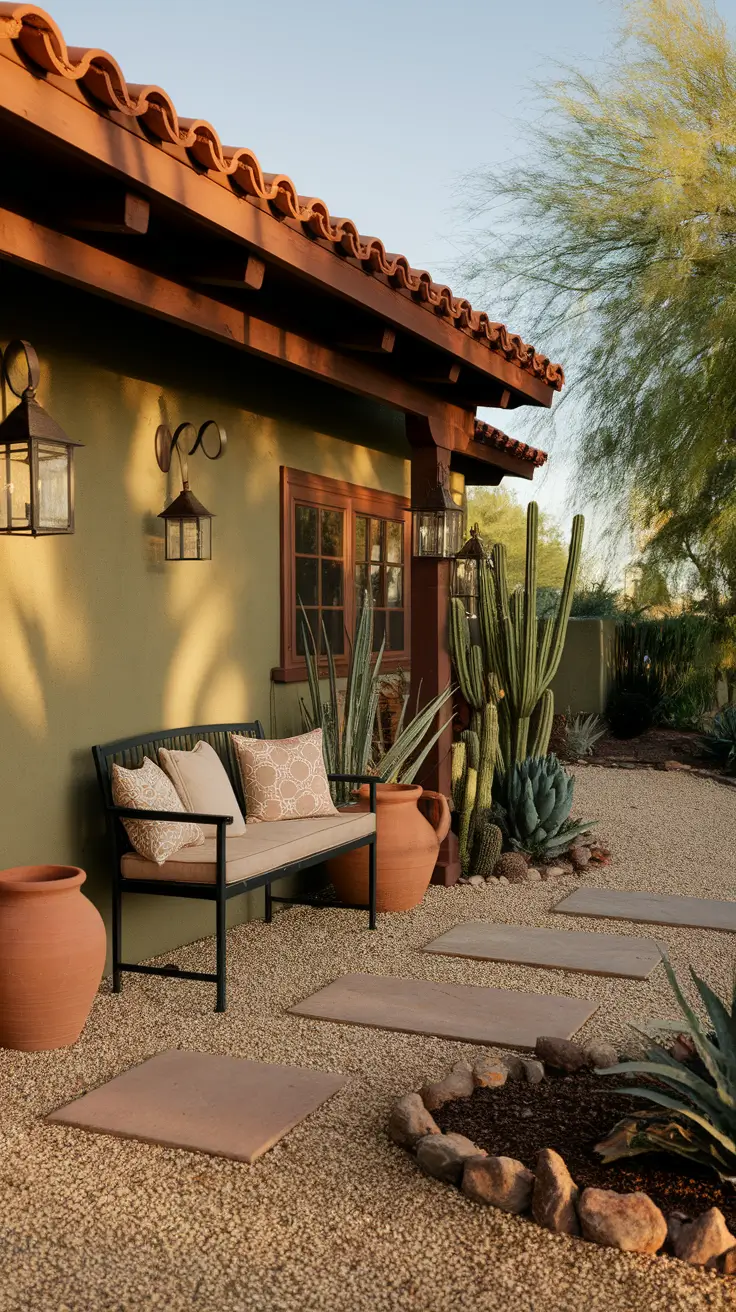
Save Pin


